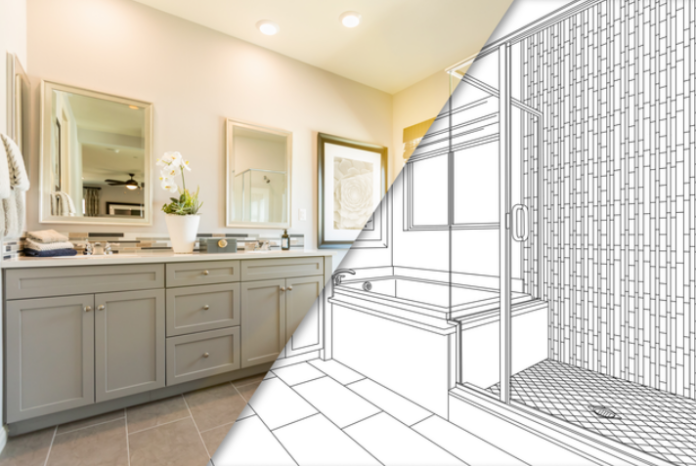Point of Interest
There’s a lot that goes into flipping a home. Without the right qualifications, plans, and guidance, a flip can turn from a potential profit into a financial nightmare, but if you’re interested in this type of project, that shouldn’t turn you off from trying. As long as you are financially equipped to handle a flip and have the right resources at your disposal, you can potentially turn a nice profit in a relatively short period of time.
You may have heard the phrase “flipping a house” from friends, family, or one of the many reality TV shows on air documenting the process of buying a fixer-upper and selling it at a profit. If you’re getting your information from reality TV, though, you may be under the impression that all would-be flippers can make a lot of money from flipping houses. The truth is, you can – as long as you know how to flip a house the right way. Prospective flippers will want to know that they’re in the right financial position to take on a flip, how to find the right house to flip and how to get the job done while protecting potential profits.
What is house flipping?
House flipping is the term given to the process of purchasing a home that’s in need of repairs and upgrades, completing those repairs and upgrades, and then reselling or renting the home for a profit. Of course, upgrades and decorating is where homeowners need to be careful as they can overspend here. This can be difficult for house flippers because they need to create an attractive interior that appeals to many, whilst also keeping it within budget. Some house flippers have recently been using a home interior design company that can help them design the best home they can, ensuring it will be aesthetically pleasing for many people looking to buy the home. For many homebuyers, it’s all about the interior. This is why some house flippers will spend more on this to ensure it looks attractive for more people. By doing this, there is more chance of people purchasing the home. Purchasing with the intent of immediately reselling is the most popular form of house flipping, but some flippers go through the process to create rental home investments rather than selling them.
Rental markets are growing in several cities throughout the country, and there are several areas investors can look to purchase a house, flip it and then put it back on the market as a rental.
According to Yahoo Finance, the current top 15 rental market cities in the U.S. are:
1. Arlington, Texas
2. Orlando, Florida
3. Jacksonville, Florida
4. Colorado Springs, Colorado
5. Columbus, Ohio
6. Seattle, Washington
7. Phoenix, Arizona
8. Charlotte, North Carolina
9. Tampa, Florida
10. St. Petersburg, Florida
11. Las Vegas, Nevada
12. San Antonio, Texas
13. Austin, Texas
14. Madison, Wisconsin
15. Durham, North Carolina
What all these cities have in common are solid metrics in population growth, employment growth, rental yield and home value increases. While you could purchase an existing home and turn it into a rental property, flipping the house first just adds to the potential profits. And when you are looking to put the property back on the market, this could help to make all of the difference. You could also enlist the help of the best property management jacksonville fl companies, or similar services in your area, so they can point you in the right direction of any other things that you can do to ensure that you get more than enough profit for it. Not only that, but they will also be able to help you when it comes to screening tenants and showing and advertising the property. This could put you in good stead after you’ve gone through the process of flipping the house.
House flipping requirements
Before embarking on your first flip, make sure you meet the requirements to take on a flip. If you jump into a project without having the right prerequisites, you could find yourself in a difficult financial situation that eats up all your profits and may even face a loss in return.
1. Good credit
Unless you have large amounts of cash you’re willing to invest in a flip, you’re going to have to get a mortgage loan for your investment property. You may not be able to get a loan if you don’t have good to great credit, or you may end up paying such a high interest rate that it ruins your potential profits. If your financial picture is subpar, work on fixing your credit before taking on additional higher risk debt. Whatever your credit situation, it’s important to find someone like a uk commercial mortgage broker who knows your financial health inside and out and can give you professional advice on proceeding in acquiring an appropriate mortgage for your new property.
2. Cash reserves
When flipping a house, you can only do your best at estimating what the costs of the repairs and upgrades will be. In reality, there will almost certainly be additional costs and surprises you didn’t plan for. If you haven’t saved the money for those costs or rolled them into your loan, the money will be coming out of pocket. If you don’t have the financial liquidity to deal with surprise costs – some of which can be significant due to unexpected structural issues – flipping houses might not be a good fit for you.
3. Easy access to trustworthy contractors
If you’re flipping houses you’re likely not planning on doing all of the construction work on your flip on your own. You may choose to do some cosmetic work to save costs, but you will need outside help for things like knocking down walls, redoing plumbing, or any other major construction tasks. You’re at a disadvantage if you don’t have access to contractors that you can trust to be honest with you about the work that needs to be done and the cost that comes with it.
This becomes especially important if you don’t know a lot about construction. Contractors can tell you anything, but without a strong cache of background knowledge on the subject, you have to trust they’re telling you the truth. When they’re not, things can get expensive.
How to find the right houses to flip
Once you’ve identified that you’re a good candidate to invest in a flip, it’s time to find the right property. While each successful flipper has their own strategy for picking winners, there are some metrics deemed important across the board.
1. Market value
If the house you purchase to flip is too expensive, it’s going to be difficult to turn a profit. Find a property that you can get a bargain on and then turn around and sell for a much higher rate.
A term you may have heard before that’s important here is comps. Comps is short for comparables and refers to houses in the area that are similar to the one you’re looking to create. Find comps that are similar to what you are upgrading your flip to in order to see what you may be able to sell for. If every comp in the area is selling for no more than $350,000, it’s hard to believe you’d get much more than that even with significant upgrades.
2. Estimated renovation costs
One of the toughest nuts to crack with house flipping is determining what it’s going to cost to bring the house up to the standard you want it to be. If you have a contractor you trust, they can help you walk the property and gauge what it’s going to cost. Keep in mind, though, that there is a strong possibility things will get more expensive than expected. You can’t always knock down walls or look under the floor before buying a home to see what bigger problems may be lurking. Those are often issues that come up after you’ve purchased the home and can add a ton of extra costs to your flip.
Do your best to estimate the maximum amount repairs, upgrades and other fixes will cost, and make sure to leave a buffer for unexpected issues. If you feel you can turn a nice profit based on what you have to pay for the house, what it will cost to fix and what you can turn around and sell (or rent) it for, you may have found a winner.
How to flip a home
Once you’ve found the right home for a flip and have identified the potential for profit, it’s time to get started. Make sure you fully understand your plan forward before buying the house and becoming heavily invested in the process.
1. Figure out financing
Determine how you are going to pay for the house and the cost of repairs and upgrades. If you have the cash, you can always purchase the house and pay for your renovations in cash. This is risky, but it does increase your ability to make higher profits. Other options include taking out conventional loans or “hard-money” loans, which are specifically designed for flippers. Based on your experience with flipping, you may be able to get improved rates on these short-term flip loans.
2. Develop a list of repairs and upgrades
You’ll need to decide what you’re going to improve based on what it will do to the home’s value and what you can afford without eating up profits. Remember, knowing where your comps are will help you decide how much you can spend while still leaving room for profit. If an upgrade does not seem to bring added value in the area you’re in, opt for something that has the potential for a higher return. You also need to make sure that your improvements are making the property look more attractive, both on the inside and outside. The exterior of the property is often forgotten about, however, it’s the first thing that a potential buyer will see. This is why it’s so important to focus on the curb appeal of the home. One thing that can increase the value of the home is upgrading the siding. By using this James Hardie Siding ultimate guide, you can learn all about the benefits of using this type of siding. Hopefully, this will give you a reason to change the siding and improve the curb appeal.
3. Buy the house and get started
Once you have a plan and financing is arranged, it’s time to purchase the house and get started. Begin completing the repairs and upgrades in accordance with the plan that you developed. Once the home is complete – or when you get close – start reaching out to realtors and generating a buzz for the property. The quicker you can complete the flip and the quicker you can sell the house, the more money you stand to make.
What is the 70% rule, and why do you need it?
If you’re not sure where to start on finding a property with enough value to flip, you can start with the 70% rule. This rule is utilized by many flippers in the industry to get an idea of whether a project is worth the investment or not.
Start by figuring the homes after repair value (ARV) and the cost of repairs/upgrades. Take 70% of the home’s ARV and subtract the rehab costs. The number you get is the maximum you can pay for that property and still turn a decent profit based on these guidelines.
For example, let’s say you find a home that you think you can sell for $200,000 after repairs. You also figure that the repairs will cost $40,000. 70% of $200,000 = $140,000. Subtract the $40,000 in rehab costs from that number, and you get a maximum purchase price of $100,000. You should not pay more than $100,000 for this house if you want to make a worthwhile profit. If you can’t purchase the home for that amount, it may be too risky to invest in.
Story credit to Jason Wesley/Interest.com.
Photo credit to Interest.com.



































